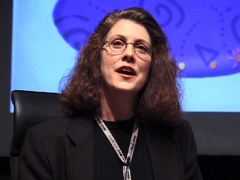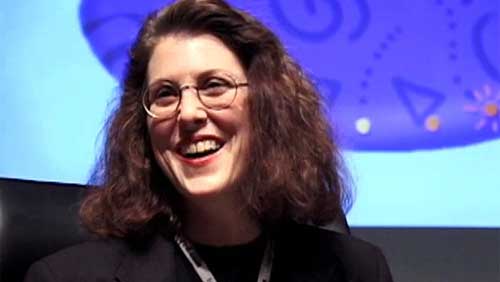Brenda Laurel spoke at TED in early 1998 — at a watershed moment. In 1997, she launched Purple Moon to make smart computer games aimed at girls. By 1999, the company had come to a much-publicized end. But between start and finish, Purple Moon marked a sea change in the girl-game market. The TED Blog interview Laurel via email last week, to get the rest of the Purple Moon story, and to talk about how the experience changed her and (just maybe) changed the world.
 Brenda Laurel: Why not make video games for girls?
From the interview: I adored those [games]. I still get email from young women who still play them in order to hear the stories at the end of each path, because they “need to.” We even found a couple of girl-generated sites for trading stones outside of the Purple Moon world, as some of them became “rare.” I see that Facebook has this sort of feature now, and it makes me smile.
Brenda Laurel: Why not make video games for girls?
From the interview: I adored those [games]. I still get email from young women who still play them in order to hear the stories at the end of each path, because they “need to.” We even found a couple of girl-generated sites for trading stones outside of the Purple Moon world, as some of them became “rare.” I see that Facebook has this sort of feature now, and it makes me smile.
Can you talk a bit about Purple Moon’s development in the two years after this talk — you mention more Rockett titles, for instance. Did you change the later games based on feedback from early Rockett players?
Yes, but in a more general way. One thing girls told us they wanted was the ability to make up their own stories about the characters, and to make up new characters and possibly put themselves as characters into the stories. So we developed a series that let girls make their own Rockett comic strips, complete with the ability to design new characters and even to choose their clothes (Rockett’s Adventure Maker) — Andrea Futter and Grace Chen did amazing work and figured out how to make those made-up characters look right in different positions, and how to get 3 dimensions into the comic frames.
Then we developed a series based on soccer (The Starfire Soccer Challenge), because women’s soccer was such a big deal to girls in that time period — during the time when American women were getting close to winning the World Cup. We did a boatload of research on how girls engage with sports, and learned, among other things, that boys engaged more from the perspective of watching sports on TV (hence all the TV-like UIs for sports games in those days), whereas girls engaged socially and in the first person. This research had a huge influence on both the plots and the UI for the Starfire series.
The moderate success of the first Secret Paths title led us to develop two more. I adored those titles. I still get email from young women who still play them in order to hear the stories at the end of each path, because they “need to.” We also learned from the huge success of the website that girls really liked being able to write articles for the Whistling Pines newspaper — that is, engage as fans in cultural production! — and they loved to collect and exchange the virtual secret stones and other goodies on the site. We even found a couple of girl-generated sites for trading stones outside of the Purple Moon world, as some of them became “rare.” I see that Facebook has this sort of feature now, and it makes me smile.
Since 1999, when Purple Moon ended, can you discern a line from your work to the next generation of games and online worlds? What lessons do you think the industry as a whole learned from your work?
It was a hard time, in that Mattel acquired and killed almost every company working in the girl space, with the exception of American Girl, which they acquired and kept alive for a while. But they had put some ungodly amount of money into that effort — all to protect Barbie — and by the next year were unable to service any of those brands. Eventually they closed their interactive group and the queen who ate us all up — Jill Barad — got ousted as CEO.
I think that the industry as a whole learned from the girl game movement that their audience could be much broader. This has come of age with things like the Wii. I think that interventions like Purple Moon enhanced girls’ comfort with computers, which we set out to do, and brought girls roaring into the online game space — eventually becoming major players in game worlds like World of Warcraft and, of course, the Sims. Will Wright has always designed with female players in mind. I don’t know whether he learned anything from us, but we were certainly on the same beam.
The “emotional navigation” interface we developed for the Rockett series has even turned out to be useful for working with folks with autism in helping them read emotional cues. I also got a fair amount of fan mail from adult men who thanked us for helping them understand how females think. There would have been another market there if we’d had time to pursue it (hee hee).
One of the coolest things that has happened is that, as the players get older, when I get email from one of them I can send them my book about the whole adventure from a business and cultural perspective, Utopian Entrepreneur, so they can see how the sausage was made. Some of them write back and tell me that they’re going to explore starting their own businesses as a result. So it’s a lovely closing of the circle.
Let’s discuss one of the powerful ideas in your talk: the idea of creating positive change through pop culture. Can you point to some companies or entities that you think are carrying this torch now? Who should be? Where would you look next, for the next you?
Things have changed so much, it’s hard to say which torches are being carried, and I don’t know that I can take any credit for any of them, but I see fellow travelers. Certainly, Will Wright continues to carry his own lovely torch of paying great attention to what players are doing in-world and tweaking the world continuously to help them along paths they seem to be enjoying. The whole Serious Games movement is carrying the torch of using games to help people deal with “serious” issues like health and citizenship, and the quality of the game design in that corner of the world is dramatically better than it used to be when “educational gaming” was a kind of ghetto populated by lots of absent-minded professors without a clue about real game dynamics.
Every year or so somebody “rediscovers” the “girl space” in the market, but I don’t sense that the goals for engaging it are as politically and culturally activist as ours were. In a way, the need for the kind of cultural intervention we made with Purple Moon no longer exists, in that girls and women are full participants in the world of computer-based interactivity, but we still have a problem with female designers getting their work out there. And there are many genres and areas of interest for girls and women that remain untouched. Heroes like Tracy Fullerton (USC), danah boyd (now at Microsoft, I believe), Justine Cassell (Northwestern) and Henry Jenkins (founder of the Comparative Media Studies program at MIT and moving now to USC) keep the flame burning for women in gaming.
I look for that generation of Purple Moon girls to shake things up in the near future.
Are there lessons from your Purple Moon experience that you make a point of teaching your students now?
You bet. One of the first courses they get in our program is Design Research, where they learn methods of ethnographic study that I learned from my pals at Cheskin while working on Purple Moon. I fervently believe in research as a necessity for good design and I teach it that way. We also have a required course in Strategy, Entrepreneurship and Ethics in the Grad Program in Design that I chair at CCA. Our students leave the program knowing how to speak business.
In more general terms, I try to make sure they don’t make the mistake of self-marginalization when they are trying something non-mainstream — that they always put themselves in the center, and see themselves as the wellspring of popular culture. I love my job.
And then — what’s next for you? Are there projects you’d like to make sure our TEDsters know about?
Designing the Grad Design program at CCA has taken all my energy recently, and I’m happy to do it. Other than that, I’ve been exploring the new world of distributed sensor networks, especially in the sense of how they may be able to engage us more profoundly with the natural world. Again, this is looking at a computational / technological affordance as a way to serve a political / cultural goal — of making us aware of our profound connection to Gaia as a way of making it impossible for us to continue to be destructive in the environment.
I’m also interested in how we can use distributed sensing to discover new patterns in nature (like Richard Voss‘ discovery of pink noise and the notion that it is a kind of temporal fractal). I’ve been greatly inspired by the work of Sean White at Columbia in this area. My first paper on the topic, “Designed Animism: Poetics for a New World,” appears in (Re)Searching the Digital Bauhaus (T. Binder, J. Löwgren and L. Malmborg, Eds., Springer, 2008). You can also download it from my website.

Comments (7)
Pingback: Por qué Barbie compite con The Last of Us, Wii Sports o Call of Duty por un puesto en el Salón de la Fama de los Videojuegos | CORDOBA TV
Pingback: Perché Barbie compete con The Last of Us, Wii Sports o Call of Duty per un posto nella Video Game Hall of Fame
Pingback: The Butterfly Effect » Blog Archive » Get in the game